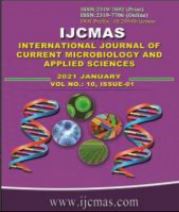


 National Academy of Agricultural Sciences (NAAS)
National Academy of Agricultural Sciences (NAAS)

|
PRINT ISSN : 2319-7692
Online ISSN : 2319-7706 Issues : 12 per year Publisher : Excellent Publishers Email : editorijcmas@gmail.com / submit@ijcmas.com Editor-in-chief: Dr.M.Prakash Index Copernicus ICV 2018: 95.39 NAAS RATING 2020: 5.38 |
Starch was extracted from traditional black rice and sorghum and compared with commercial starch from tapioca for physicochemical and functional properties. The starch from rice and sorghum was extracted using the alkali method. The results showed that all the starch samples have significantly different functional properties, pH, and color. The swelling power and solubility of tapioca starch were found to be highest, ranging from 10.50 to 30.10gg-1 and 7.35 to 27.20% (at temperature ranging from 65 to 95°C), followed by sorghum and rice starch. For bulk and tapped density of the sample were in the order: sorghum starch > rice starch > tapioca starch. Similarly, the water and oil absorption capacity of samples followed the order: tapioca starch > sorghum starch > rice starch. The pH values of tapioca, rice, and sorghum starch were found to be 5.35, 5.85, and 6.48 respectively. Color of all starch showed high whiteness values (L* ranging from 94.39 to 94.94) with slight yellowish tone (hue angle ranging from 80.28° to 98.05°), and very less a*, b*, and chroma values, hence indicating that all the starch was white. On comparing rice and sorghum starch with tapioca starch, it can be concluded that the functional and physicochemical properties of rice and sorghum starch are comparable to that of tapioca starch. Hence, rice and sorghum starch can be used in place of tapioca starch as an ingredient in the preparation of various products.
 |
 |
 |
 |
 |